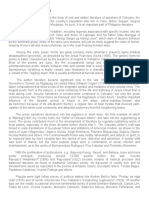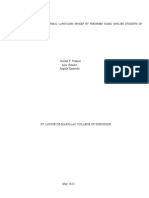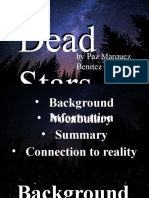Essay Format Sample
Essay Format Sample
Uploaded by
IsmailCopyright:
Available Formats
Essay Format Sample
Essay Format Sample
Uploaded by
IsmailCopyright
Available Formats
Share this document
Did you find this document useful?
Is this content inappropriate?
Copyright:
Available Formats
Essay Format Sample
Essay Format Sample
Uploaded by
IsmailCopyright:
Available Formats
Academic
Academic Paper
Paper Essay
Format Format
Here is an example of what an academic paper typically looks like. Using standard
fonts, margins, and indentations helps your paper gain credibility with an academic
audience; readers who are comfortable with your paper’s format can pay close attention
to the ideas you’re communicating.
Papers are typically
in 12 point Times
New Roman font
with double spacing
and one-inch
margins all around.
Write your name,
Writer’s Name the course, the
WRIT 1201 instructor’s name,
Professor’s Name and the date here
September 20, 2007 (unless your
instructor says
Some papers Writing an Organized Paper otherwise).
include a title that
suggests the topic. The ability to write a well-organized and insightful paper is very important in order to be
successful at the University of Minnesota. Most classes require at least one written assignment,
and professors expect a high level of writing skill. A good paper generally includes a thesis, Academic papers
often include a
paragraphs that support it, and a strong conclusion. thesis in the first
paragraph.
Every paragraph A good thesis is integral to any academic paper and should work as a general summary of the
begins with an
indentation of five argument or main point of the paper. The thesis needs to be clear, and it should outline the main
spaces (created
with the “tab” or points to be discussed. Sometimes just making a list of the basic things you plan to write about and
“return/enter” key).
then compiling them into a sentence is enough. The rest of the paper should then follow the plan
laid out by the thesis.
In general, each
In order for readers to be able to follow the logic of a paper, each paragraph should be related
paragraph should
start with a topic
to what was introduced in the thesis. A good way to start is by making a topic sentence to begin
sentence.
each paragraph. The topic sentence is often an extended or elaborated version of some part of the
thesis statement. For example, this paper’s thesis mentions “paragraphs that follow [the thesis],”
and the topic sentence for this paragraph expands on that idea. The rest of a paragraph should
Note how the
include evidence to support or explain the topic sentence. ends and
beginnings of
Once readers have been led through the paragraphs that support your main point, they will paragraphs work
to create a
expect to find a solid conclusion that discusses the significance of what they have just read. If the transition between
ideas.
thesis predicts the main point of the paper, then the conclusion emphasizes the importance of your
main point in some larger context. In the case of this paper, a conclusion might point out that
following the general guidelines for presenting your ideas in an academic setting allows your
papers to make an impact on readers. Readers appreciate your presenting a paper in a way that’s
familiar to them; in turn, they are more likely to be open to your unique perspective.
You might also like
- Solfege On The StaffDocument3 pagesSolfege On The StaffElvin Negron100% (2)
- Michel Thomas Arabic Advanced CourseDocument17 pagesMichel Thomas Arabic Advanced Coursekhairat06100% (3)
- Matrix of Montessori, HighScope and Reggio Emilia ApproachDocument10 pagesMatrix of Montessori, HighScope and Reggio Emilia ApproachChito JarciaNo ratings yet
- Talas 5Document269 pagesTalas 5Dearme ClaveNo ratings yet
- LIT - Graphic Organizer PDFDocument3 pagesLIT - Graphic Organizer PDFVicki PunzalanNo ratings yet
- 5081 Ijrse final-WikangKulitDocument13 pages5081 Ijrse final-WikangKulitGem ManzonNo ratings yet
- Ligaya NG Pagiging Lugami - Nobela at PagsasabansaDocument1 pageLigaya NG Pagiging Lugami - Nobela at PagsasabansaDale DampilNo ratings yet
- Postma 1985 The Concept of Time Among The Mangyans 1Document10 pagesPostma 1985 The Concept of Time Among The Mangyans 1Chin Geriane AmongolNo ratings yet
- Isang Dipang Langit by Amado v. HernandezDocument3 pagesIsang Dipang Langit by Amado v. HernandezVeronica CalNo ratings yet
- Final. Syllabus. Fil 101Document9 pagesFinal. Syllabus. Fil 101Elna Trogani IINo ratings yet
- Name: Nicole Cem Faith B. Aguilar Grade&Section: 11 - Confidence Score: - DEADLINE: AUGUST 12, 2020, 4:30PM Quiz No.: 1Document4 pagesName: Nicole Cem Faith B. Aguilar Grade&Section: 11 - Confidence Score: - DEADLINE: AUGUST 12, 2020, 4:30PM Quiz No.: 1Nicole Blances AguilarNo ratings yet
- LiteratureDocument2 pagesLiteratureAizel TalladaNo ratings yet
- Ang Tawo..Document8 pagesAng Tawo..Maria Cristina GornezNo ratings yet
- Evaluation of - Print Reference SourcesDocument16 pagesEvaluation of - Print Reference SourcesFhcRojoNo ratings yet
- COLLEGE UneducationDocument5 pagesCOLLEGE UneducationPatrick Galang100% (3)
- Thesis 3i's Chapter 2Document8 pagesThesis 3i's Chapter 2ValNo ratings yet
- Module 2 - Chapter 3 PDFDocument4 pagesModule 2 - Chapter 3 PDFMary Joyce SolitaNo ratings yet
- Fil 40 ReportDocument20 pagesFil 40 ReportAndrei Dizon50% (2)
- Region 8 'Pangupras' (Copra) Painting Is Made of Coconut ShellsDocument1 pageRegion 8 'Pangupras' (Copra) Painting Is Made of Coconut ShellskjhrscbnjtdnNo ratings yet
- Indian and Japanese LiteratureDocument3 pagesIndian and Japanese LiteratureJoyce Ann Aquino SolimanNo ratings yet
- Abnkkbsnplako, RoanDocument2 pagesAbnkkbsnplako, RoanRoan AsisNo ratings yet
- Multi Ling G WalDocument5 pagesMulti Ling G WalAndreaNicoleBanzonNo ratings yet
- P E O P L E: Kapalong College of Agriculture, Sciences and TechnologyDocument12 pagesP E O P L E: Kapalong College of Agriculture, Sciences and Technologyjonard rodriguezNo ratings yet
- Erlinda Kintanar-Alburo Cebuano Literature Refers To The Body of Oral and Written Literature of Speakers of Cebuano, TheDocument2 pagesErlinda Kintanar-Alburo Cebuano Literature Refers To The Body of Oral and Written Literature of Speakers of Cebuano, TheGlory Gwendolyn N. VosotrosNo ratings yet
- Analyze The Painting THE PARISIAN LIFE by Juan Luna Using The PLANES by Allice GuillermoDocument3 pagesAnalyze The Painting THE PARISIAN LIFE by Juan Luna Using The PLANES by Allice GuillermoArticle UnoNo ratings yet
- Pre Colonial PeriodDocument13 pagesPre Colonial PeriodAngelica Dyan MendozaNo ratings yet
- Cagayan State University: Keywords: Itawes Proverbs, Values, Lesson, Translation, Communicational ApproachDocument13 pagesCagayan State University: Keywords: Itawes Proverbs, Values, Lesson, Translation, Communicational Approachangie.delacruz8950No ratings yet
- 1 Social Media Influence in Informal Languages Spoken by Freshmen Based English Students of SLMCS 4Document17 pages1 Social Media Influence in Informal Languages Spoken by Freshmen Based English Students of SLMCS 4Kristel FullonNo ratings yet
- Birds of PreyDocument2 pagesBirds of Preyr1ght3r100% (1)
- Leron Leron SintaDocument8 pagesLeron Leron SintaJoyce Ann EspanolaNo ratings yet
- Against The Dying of The LightDocument15 pagesAgainst The Dying of The LightRudy Pascual AquinoNo ratings yet
- Dead Stars'Document29 pagesDead Stars'BLACKNo ratings yet
- 21 Reasons Why Children Learn Better While Using Their Mother TongueDocument4 pages21 Reasons Why Children Learn Better While Using Their Mother TongueMark CabugwasNo ratings yet
- Trivia 1Document2 pagesTrivia 1Erold TarvinaNo ratings yet
- Jamer Module 3 Foreignization and DomesticationDocument5 pagesJamer Module 3 Foreignization and DomesticationRenzo JamerNo ratings yet
- Lecture 1. Introducing Second Language AcquisitionDocument18 pagesLecture 1. Introducing Second Language AcquisitionДиляра КаримоваNo ratings yet
- Parables of The Ancient PhilosophersDocument8 pagesParables of The Ancient PhilosophersChristine Joy BaquirNo ratings yet
- Tales of ManuvuDocument3 pagesTales of ManuvuFranchezca EnriquezNo ratings yet
- Reading MaterialDocument13 pagesReading MaterialRayshane EstradaNo ratings yet
- Lopez - DISS Term Paper PDFDocument19 pagesLopez - DISS Term Paper PDFGino Lim LopezNo ratings yet
- Anak NG Dagat A LegendDocument3 pagesAnak NG Dagat A LegendChristian Josh DinoyNo ratings yet
- ImageryDocument12 pagesImagerysyafic1968No ratings yet
- Close Analysis Bob OngDocument3 pagesClose Analysis Bob OngAlkallain Brands CompanyNo ratings yet
- College of Teacher Education FIL 323 - Course Syllabus: 1. Course Number 2. Course NameDocument10 pagesCollege of Teacher Education FIL 323 - Course Syllabus: 1. Course Number 2. Course NameKRISTINE NICOLLE DANANo ratings yet
- Bagong PormalisasyonDocument6 pagesBagong PormalisasyonJillian BelaroNo ratings yet
- The Problem and Its SettingDocument25 pagesThe Problem and Its SettingBryan BatallerNo ratings yet
- 5 - Building JusticeDocument20 pages5 - Building JusticecarendleonNo ratings yet
- Kabanata 1 Batayang Kaalaman Sa WikaDocument18 pagesKabanata 1 Batayang Kaalaman Sa WikaHoworth HollandNo ratings yet
- Ancient Philippine LiteratureDocument17 pagesAncient Philippine LiteratureNoel Krish ZacalNo ratings yet
- Day of MourningDocument7 pagesDay of MourningCristell BiñasNo ratings yet
- Annabel Lee by Edgar Allan Poe - Poetry FoundationDocument2 pagesAnnabel Lee by Edgar Allan Poe - Poetry FoundationPunyo SarmingNo ratings yet
- National Literature and Its Social Dimension SY22-23Document36 pagesNational Literature and Its Social Dimension SY22-23Gian Barney NegparononNo ratings yet
- Antonio, Lilia F.: Lilia F. Antonio Was Born in Balara, Quezon City On 27 July 1949. She Is An EssayistDocument1 pageAntonio, Lilia F.: Lilia F. Antonio Was Born in Balara, Quezon City On 27 July 1949. She Is An EssayistJenelin EneroNo ratings yet
- JejemonDocument6 pagesJejemonMigrant Dagondon IgarNo ratings yet
- Written Report SociolinguisticDocument10 pagesWritten Report SociolinguisticPamela Tabios SerranNo ratings yet
- 3445 8085 1 PBDocument12 pages3445 8085 1 PBChris RosalesNo ratings yet
- Period of EnlightenmentDocument6 pagesPeriod of EnlightenmentTin CorderoNo ratings yet
- Kakayahan NG Mga Pre-Service Teachers Sa Pagtuturo NG Asignaturang FilipinoDocument9 pagesKakayahan NG Mga Pre-Service Teachers Sa Pagtuturo NG Asignaturang FilipinoAJHSSR JournalNo ratings yet
- Oral Communication: For Senior High SchoolDocument26 pagesOral Communication: For Senior High SchoolJL Burca MagdaraogNo ratings yet
- Figures of Speech and AUTOBIOGRAPHYDocument33 pagesFigures of Speech and AUTOBIOGRAPHYMarie Estela De GuzmanNo ratings yet
- Pilar of Mindanao: A Story of Courage and Love in World War IiFrom EverandPilar of Mindanao: A Story of Courage and Love in World War IiNo ratings yet
- Language-in-education Policies: The Discursive Construction of Intercultural RelationsFrom EverandLanguage-in-education Policies: The Discursive Construction of Intercultural RelationsNo ratings yet
- Reading 1 STECKER - Definition of ArtDocument10 pagesReading 1 STECKER - Definition of ArtyopyopNo ratings yet
- Uncertainty Estimation With Deep EnsemblesDocument15 pagesUncertainty Estimation With Deep EnsemblestrolllolfuckubitchNo ratings yet
- Mandala Process Palecek Alexander A Contemplative Approach To TraumaDocument46 pagesMandala Process Palecek Alexander A Contemplative Approach To Traumakarinadaparia100% (1)
- 2013 NIFT BrochureDocument80 pages2013 NIFT BrochurejanmanchiNo ratings yet
- Fiche D Eprogression Anglais - TerminaleDocument4 pagesFiche D Eprogression Anglais - Terminalecorine daNo ratings yet
- Earth & Rock Fill Dams 0MGT206 (PEC) : Syllabus For Master of Technology Civil Engineering (Geotechnical)Document3 pagesEarth & Rock Fill Dams 0MGT206 (PEC) : Syllabus For Master of Technology Civil Engineering (Geotechnical)krupaNo ratings yet
- Example of ResearchDocument12 pagesExample of ResearchHelaena Jae Icamina RamirezNo ratings yet
- Module 2Document19 pagesModule 2James DellavaNo ratings yet
- Criteria For Marking Translations From English Into The Target LanguageDocument3 pagesCriteria For Marking Translations From English Into The Target LanguageAna INo ratings yet
- Section 504 of The Rehabilitation Act of 1973: Grand Canyon University EAD-505Document13 pagesSection 504 of The Rehabilitation Act of 1973: Grand Canyon University EAD-505api-309737337No ratings yet
- Classroom Observation Plan Mnhs Mark Anthony A. RobleDocument2 pagesClassroom Observation Plan Mnhs Mark Anthony A. RobleUmmycalsum British SumndadNo ratings yet
- Latest Proposal Seminar in ManagementDocument12 pagesLatest Proposal Seminar in ManagementFifi AqiraNo ratings yet
- Design Research For ' Projects: EverydayDocument71 pagesDesign Research For ' Projects: EverydayPoppy GoldsmithNo ratings yet
- Consolidated Analysis Report For Phil IRI Maribago High SchoolDocument6 pagesConsolidated Analysis Report For Phil IRI Maribago High SchoolIris Jomalon33% (3)
- The Science of Strong Business WritingDocument4 pagesThe Science of Strong Business WritingHannah YeeNo ratings yet
- AI Associate Trailhead Badges NotesDocument94 pagesAI Associate Trailhead Badges NotesmozillatkcNo ratings yet
- Machine Learning Specialization CloudxLab PDFDocument12 pagesMachine Learning Specialization CloudxLab PDFBibek GuptaNo ratings yet
- Eend 676 Collaborative Suspenseful Audio Project 2Document2 pagesEend 676 Collaborative Suspenseful Audio Project 2api-398899331No ratings yet
- Competition As A Teaching StrategyDocument4 pagesCompetition As A Teaching StrategyLisa TalNo ratings yet
- Communication For Various PurposesDocument64 pagesCommunication For Various PurposesTeresa MadrigalNo ratings yet
- Seminar On DemonstrationDocument14 pagesSeminar On Demonstrationmohamad dildarNo ratings yet
- I. Objectives: A. Content StandardsDocument12 pagesI. Objectives: A. Content StandardsI am JezzNo ratings yet
- Chapter 7Document4 pagesChapter 7JackieNo ratings yet
- The Correlation Between The Students' Pronunciation Mastery and Their Ability in SpeakingDocument6 pagesThe Correlation Between The Students' Pronunciation Mastery and Their Ability in SpeakingAntcNo ratings yet
- Name: Casipong, Shemian B. Beed 4-A: Delivering My LessonsDocument13 pagesName: Casipong, Shemian B. Beed 4-A: Delivering My LessonsBEED 3-ANo ratings yet
- Colección de HipertextosDocument110 pagesColección de HipertextosMiguel Angel Riaño TrujilloNo ratings yet
- Tilley 2001 Ethnography and Material CultureDocument15 pagesTilley 2001 Ethnography and Material CultureIlona GyongyNo ratings yet

























































































